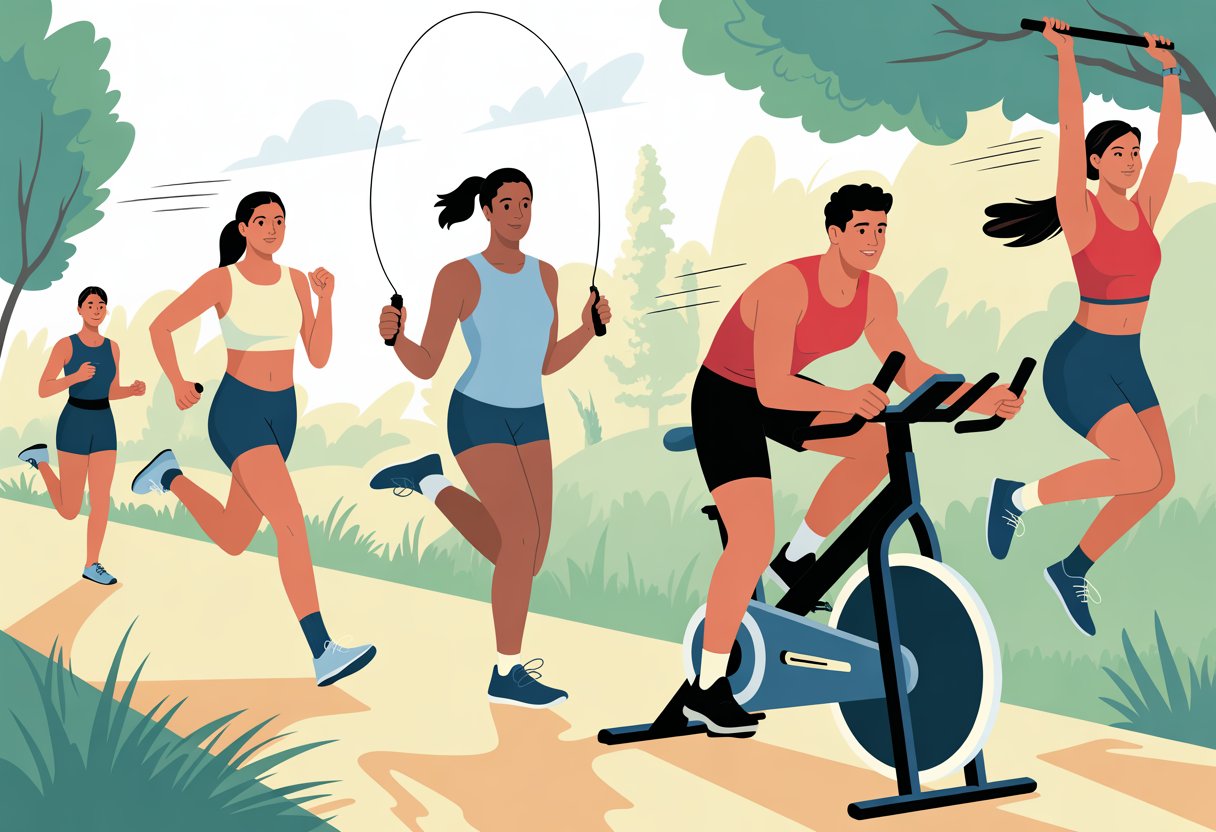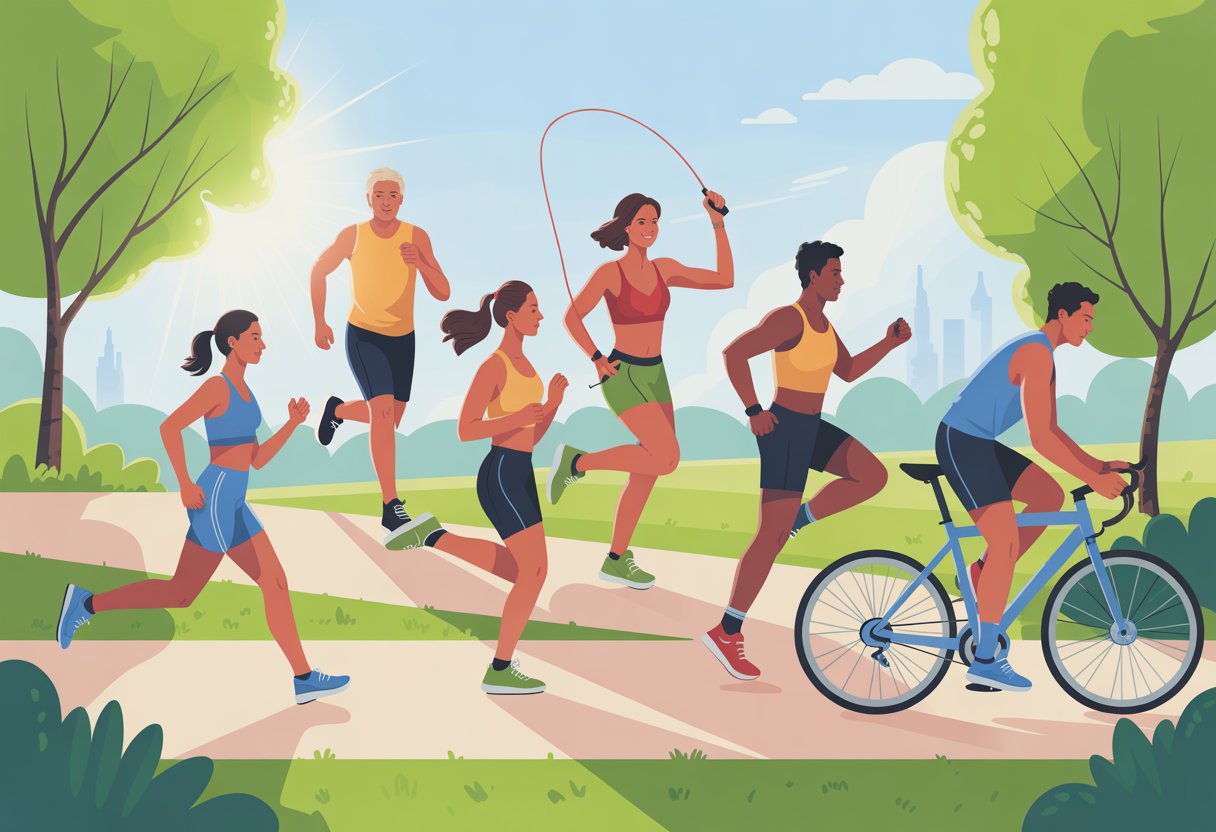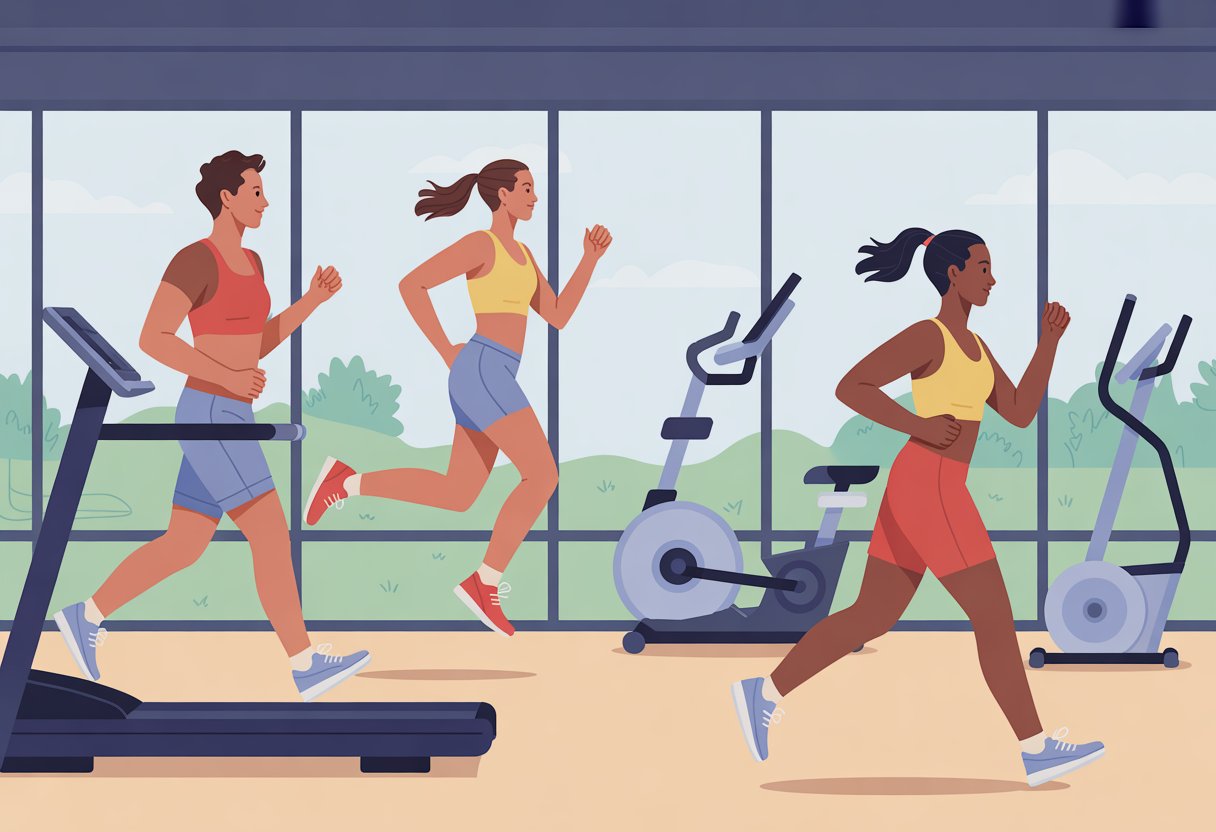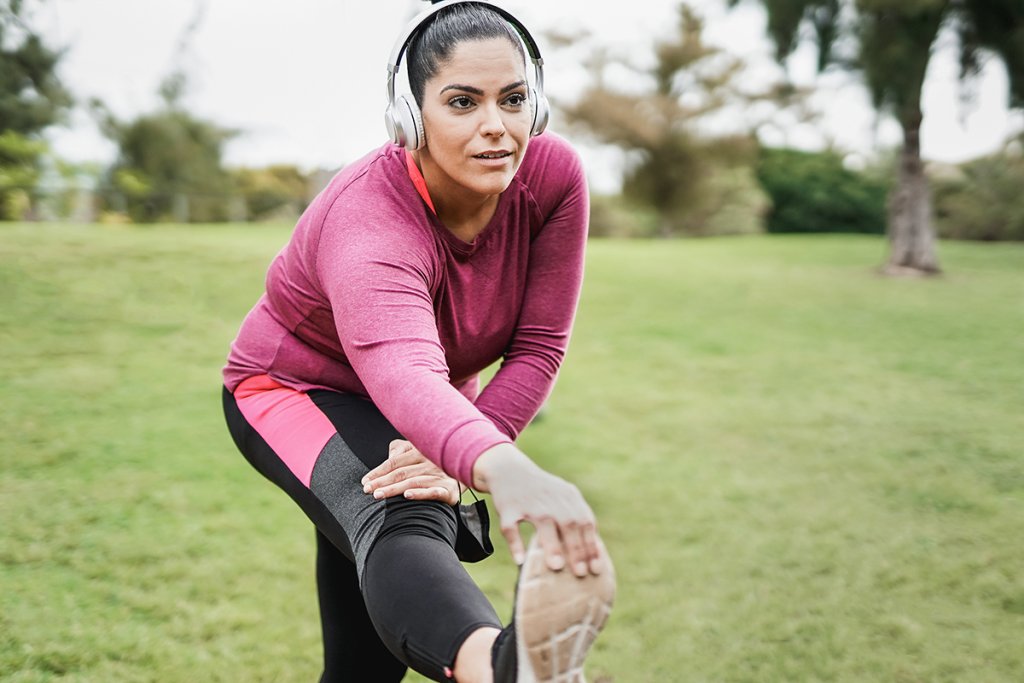Cardio exercise is a staple for anyone aiming to lose weight, as it helps burn calories quickly and supports overall fitness. The best cardio exercises for weight loss include options like running, cycling, HIIT (High-Intensity Interval Training), swimming, and dancing, all of which have been shown to be effective for torching calories and boosting metabolism. Whether someone enjoys fast-paced routines or prefers moderate-intensity activity, there are cardio workouts to fit every lifestyle and skill level.

Trying different cardio routines can keep workouts interesting and may produce better results over time. From jumping rope at home to swimming laps at the gym, exploring a variety of exercises helps people stay motivated and continuously challenge their bodies.
Key Takeaways
- Cardio is essential for effective weight loss.
- Top exercises include running, HIIT, swimming, and cycling.
- People should choose routines that match their fitness level and interests.
Understanding Cardio Exercise and Weight Loss
Cardio exercise helps the body burn calories and fat more efficiently. It plays a significant role in supporting weight management and heart health, often working best when combined with other forms of physical activity.
How Cardio Supports Fat Loss
Cardio, also known as aerobic exercise, increases heart rate and breathing, which helps the body use stored fat for energy. This activity involves major muscle groups and keeps the cardiovascular system active throughout the workout.
Some popular forms of cardio include running, swimming, cycling, brisk walking, and group fitness classes. These exercises raise the heart rate into the moderate or vigorous zone, which is effective for fat loss.
Experts recommend 150 to 300 minutes of moderate-intensity cardio per week, such as brisk walking or cycling. For those who prefer high-intensity activities like running, 75 to 150 minutes may be sufficient. Consistent cardio helps reduce body fat, especially when paired with healthy eating habits.
The Role of Calorie Burn and Metabolism
Cardio exercises increase overall calorie burn both during and after a workout. Activities like jogging or fast cycling burn more energy per minute compared to many other exercises.
Calorie Burn Examples (approximate per hour):
| Activity | Calories (150 lb person) |
|---|---|
| Running (6 mph) | 600 |
| Cycling (moderate) | 500 |
| Swimming | 400 |
| Brisk Walking | 300 |
Regular cardio can also temporarily boost metabolism, meaning the body uses more energy for a period even after the exercise stops. This effect, known as “afterburn,” helps with ongoing calorie loss.
Aerobic Exercise vs. Strength Training
Aerobic exercises and strength training both support weight loss but work in different ways. Cardio exercises mainly increase calorie use during the activity and improve cardiovascular health.
Strength training builds muscle mass, which can raise resting metabolism over time. More muscle means the body burns more calories even while at rest.
A balanced routine that includes both cardio and strength training offers the best results for fat loss and long-term health. This approach can help individuals lose weight, maintain muscle, and improve overall fitness.
Top Cardio Workouts for Effective Weight Loss
Different forms of cardio offer unique benefits for burning calories, building endurance, and improving fitness. Some options engage large muscle groups, while others allow for varied intensity depending on personal preference and skill level.
Running and Jogging
Running and jogging are classic cardio workouts that remain popular for weight loss. These activities use the legs and core, steadily raising the heart rate and calorie burn. Even moderate jogging can burn around 300–400 calories per 30 minutes, depending on weight and speed.
Many people enjoy running outdoors for the variation in terrain and fresh air, while others prefer treadmills for timing and pace control. Intervals—short bursts of running mixed with slower jogging—help further increase calorie expenditure and build cardiovascular endurance.
Benefits:
- Improves heart and lung function
- Effective for fat loss at various fitness levels
- Offers flexibility in intensity and duration
Beginners can start with a walk-jog routine, gradually increasing running intervals as fitness improves. Proper footwear and maintaining good form reduce injury risk.
Cycling and Stationary Biking
Cycling, whether outdoors or on a stationary bike, provides a low-impact cardio workout that is easier on the joints than running. It effectively works the lower body, including the quadriceps, hamstrings, and calves, while also engaging the core for balance.
A typical moderate-intensity ride can burn 200–400 calories in 30 minutes, depending on resistance and speed. Many choose cycling for its customizability; adjusting resistance and speed allows individuals to tailor the intensity to their fitness level.
Benefits:
- Suitable for varying endurance levels
- Engages major leg muscles
- Easier on knees and hips than running
Group cycling classes and virtual rides can boost motivation. Safety measures, like wearing a helmet outdoors, are essential for preventing injuries.
Rowing for Full-Body Engagement
Rowing, using a machine or on water, stands out because it works both the upper and lower body at once. Each stroke involves the legs, back, arms, and core muscles, ensuring a balanced and intense workout. Rowing is effective for calorie burning, averaging 250–350 calories in 30 minutes for many users.
This exercise emphasizes power and endurance, helping to improve heart health and muscular strength simultaneously. The rhythm of rowing can be adjusted for steady-state cardio or high-intensity intervals, making it versatile for different goals.
Benefits:
- Full-body muscle engagement
- Increases endurance and cardiovascular capacity
- Adjustable resistance suits all fitness levels
Rowing machines can be found in most gyms, and many offer digital tracking for pacing and progress, which helps users stay motivated and monitor improvements over time.
High-Intensity Interval Training (HIIT) for Maximum Results
High-Intensity Interval Training (HIIT) pushes the body with intense exercise bursts followed by short recovery periods. This approach increases calorie burn and supports fat loss more effectively than steady-state cardio.
What is HIIT and How Does It Work?
HIIT consists of alternating periods of high-power effort and low-intensity recovery. A typical workout includes several cycles, such as sprinting for 30 seconds followed by walking for 60 seconds. The pattern might be repeated for 10 to 20 minutes.
The method can be applied to many workouts—running, cycling, rowing, or even bodyweight exercises. By working at nearly maximum effort during intervals, the body’s heart rate quickly spikes, making the most of both aerobic and anaerobic systems.
This type of training triggers “afterburn,” where the body continues burning calories after exercise due to excess post-exercise oxygen consumption (EPOC). HIIT’s structure is appealing for those who want efficient workouts that fit busy schedules.
Best HIIT Cardio Exercises
Some of the top HIIT cardio exercises target the full body and can be done at home or in the gym. Popular options include:
- Jumping Jacks: Great for getting the heart rate up fast.
- Mountain Climbers: Work the arms, core, and legs.
- High Knees: Increases speed and coordination.
- Squat Jumps: Builds lower-body power.
- Sprints (outdoors or treadmill): Excellent for boosting cardiovascular health.
- Boxing/Shadowboxing: Engages upper body and sharpens reflexes.
- Rowing: Combines upper and lower body for maximum calorie burn.
Pairing two or three of these moves in intervals—like 40 seconds of effort, 20 seconds rest—creates a powerful fat loss workout.
Benefits of Interval Training for Weight Loss
HIIT is shown to be more effective for calorie burn within a shorter time frame compared to traditional cardio. Studies indicate that the intense bursts help improve metabolism and burn more fat both during and after workouts.
Interval training can help preserve lean muscle mass while focusing on fat loss, which helps maintain strength even when reducing calories. The engaging and variable format keeps workouts interesting and motivational.
HIIT also supports heart health and increases endurance. As the body adapts, fitness levels improve, and individuals often see better performance in less time.
Additional Cardio Exercises to Enhance Your Routine

Exploring a variety of cardiovascular exercises can help improve endurance, target specific areas like belly fat, and introduce low-impact options. Key movements like swimming, high-intensity belly-burning routines, and dynamic squats can be adapted for nearly any fitness level.
Swimming as a Low-Impact Alternative
Swimming is excellent for those seeking a low-impact form of exercise that spares the joints while delivering a full-body workout. It improves cardiovascular endurance and also strengthens nearly every major muscle group, including the core, back, shoulders, and legs.
For people managing injuries or joint concerns, swimming offers a way to keep active without added strain. Water resistance makes movements more challenging, encouraging calorie burn and toning. Swimmers can alternate between freestyle, breaststroke, and backstroke for variety, or add in water aerobics to further diversify workouts.
Cardio Workouts for Burning Belly Fat
Targeting excess belly fat requires consistent effort, as spot reduction is not possible. However, specific forms of cardio—such as HIIT (high-intensity interval training), running, and cycling—have proven effective at reducing overall fat, which includes visceral fat around the abdomen.
Short bursts of intense activity, like sprints or fast-paced cycling, followed by rest or lower-intensity movement, can keep the heart rate elevated. This method increases caloric burn both during and after exercise through the afterburn effect. Incorporating routines that mix intervals, such as alternating between one minute of high effort and one to two minutes of active recovery, provides optimal results.
Incorporating Squats and Power Moves
Squats are a compound movement that work multiple muscle groups—glutes, quadriceps, hamstrings, and core. Adding power to the movement, such as jump squats or kettlebell swings, shifts a traditional strength exercise into a cardio powerhouse.
Incorporating these power moves into routines raises the heart rate, helping to burn more calories in less time. They also enhance muscular endurance while improving balance and athletic performance. For variation, circuit these movements with other bodyweight exercises like lunges or push-ups to create a challenging, dynamic workout.
Try structuring a short circuit as follows:
| Exercise | Duration |
|---|---|
| Jump Squats | 30 sec |
| Push-Ups | 30 sec |
| Mountain Climbers | 30 sec |
| Rest | 30 sec |
Repeat the circuit 3–4 times for maximum effect.
Tailoring Cardio Workouts for Your Fitness Level

Different fitness levels call for different cardio routines and strategies. Adjusting workouts and tracking progress helps create steady, sustainable results.
Creating a Balanced Cardio and Strength Plan
Blending cardio with strength training can promote better fat loss and improve overall fitness. Beginners may benefit from starting with low-impact options, like brisk walking, cycling, or using an elliptical machine. These activities put less strain on the joints while still raising the heart rate.
As fitness improves, adding high-intensity interval training (HIIT) or using equipment like treadmills and rowing machines helps increase calorie burn and challenge the muscles. For those seeking structure, many gyms and fitness services offer group classes or personal trainers that guide members through balanced routines.
A sample weekly plan might look like this:
| Day | Cardio Activity | Strength Training |
|---|---|---|
| Monday | 30-min brisk walk | Bodyweight exercises |
| Wednesday | 20-min HIIT cycling | Resistance bands |
| Friday | 30-min treadmill jog | Dumbbell workout |
Variety keeps workouts interesting and works different muscle groups. Rest days should be included to allow the body time to recover and reduce injury risk.
Measuring Progress and Setting Goals
Tracking workouts is key for motivation and long-term success. They can use fitness apps, logs, or wearable trackers to monitor time, intensity, and calories burned during cardio sessions.
Short-term goals, like increasing workout length by five minutes or jogging farther, help maintain focus. Over time, goals may shift to lowering body fat percentage or improving speed on the treadmill.
Building in regular fitness assessments, such as checking resting heart rate or doing a timed row, lets individuals see measurable improvements. It’s important for each person to set goals that fit their current ability and adjust as their strength and fitness level improve.
Frequently Asked Questions
Cardio exercises help with weight loss by increasing calorie burn and boosting heart health. Many options can be done either at the gym or home, even without equipment.
What are the top aerobics exercises for fat loss?
Running, swimming, cycling, and group aerobic dance classes are highly effective for burning calories. These activities can be adjusted in intensity to suit different fitness levels.
Boxing and brisk walking also provide strong aerobic benefits. Mixing these with interval training can speed up fat loss.
Which at-home cardio workouts are effective for shedding pounds?
Jumping rope, high knees, and burpees are simple and effective for home use. These exercises raise the heart rate quickly and require little space.
Bodyweight circuit routines combining squats, lunges, and jumping jacks can be efficient for calorie burn. Videos or online guided classes can add structure for at-home workouts.
Can you suggest no-equipment cardio exercises that aid in weight loss?
Burpees, mountain climbers, jumping jacks, and squat jumps are all excellent choices that do not require any equipment. These movements target large muscle groups to maximize calorie burn.
Stair climbing at home or running in place are also effective and accessible.
What is the best cardio routine to target and reduce belly fat?
While spot reduction is not possible, interval training that alternates high and low intensity—such as run-walk intervals or circuits—helps reduce overall fat, including in the abdominal area.
Consistent moderate to vigorous cardio combined with strength training supports body fat reduction in the long term.
What workouts are best suited for females looking to lose fat?
Females may benefit from cardio routines like brisk walking, rowing, cycling, or aerobic dance. These activities are accessible and often enjoyable.
Adding strength-based movements such as lunges or resistance circuits to cardio helps preserve muscle mass during weight loss.
How effective is doing 1 hour of cardio daily for weight loss?
Performing one hour of moderate to vigorous cardio each day can significantly increase calorie burn and help with weight management, especially if combined with a healthy diet.
It’s important to choose sustainable activities and allow for adequate recovery to avoid overtraining.













